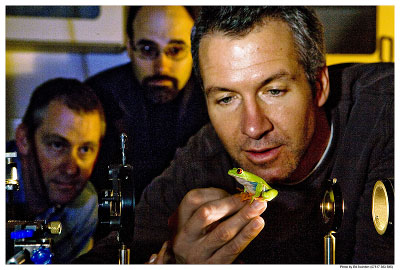?
Physicists join fight to save amphibians from extinction
Physicists join fight to save amphibians from extinction
mongabay.com
November 20, 2007
Physicists have joined the fight to save amphibians from extinction by using Optical Coherence Tomography (OCT) to investigate the properties of frogs skin.
Physicist Dr Mark Dickinson and biologist Dr Richard Preziosi from the University of Manchester are working with Andrew Gray, Curator of Herpetology at the Manchester Museum, to see whether increased cloud cover in the tropics is making it more difficult for tree frogs to protect themselves from deadly chytrid fungal infection, a disease blamed for widespread declines of amphibians across four continents.
 Dickinson, Preziosi and Gray (l to r) in lab with tree frog |
The subject tree frogs live on leaves and branches where they can bask in direct sunlight–unusual behavior for amphibians, which normally avoid prolonged exposure to high levels of sun due to the risk of overheating and dehydration. The researchers believe this “sunbathing” kills the Chytrid fungus, but that increased cloud cover is reducing opportunities for these sn-loving tree frogs to expose themselves to light thus making them more susceptible to disease.
To date the researchers have “observed that the skin of basking tree frogs sometimes undergoes a visible change and becomes almost metallic in texture,” according to a statement from the University of Manchester. “They think that when this happens, the level of absorption and reflection and the skin temperature also changes.”
Dickinson and collegauges are testing their hypothesis by using OCT to compare “structural changes in the skin of tree frogs with the structural changes in the skin of frogs that do not have the same high levels of infrared reflectance.”
The researchers plan to apply spectral reflectance techniques to tree frogs living in their natural habitat in Costa Rica next year.
“With a third of the world’s amphibians currently under threat it’s vitally important we do our utmost to investigate the reasons why they are dying out at such an alarming rate,” said Andrew Gray. “The imaging technique we use is completely non-invasive and does not harm the frogs in any way. As an animal conservationist, I simply would not allow any research that distressed these amazing creatures.”